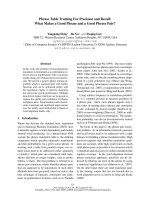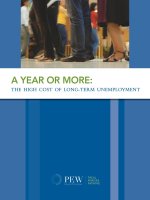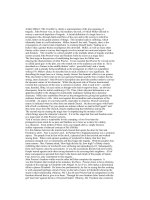maxwell - the price is wrong; understanding what makes a price seem fair and the true cost of unfair pricing (2008)
Bạn đang xem bản rút gọn của tài liệu. Xem và tải ngay bản đầy đủ của tài liệu tại đây (1.38 MB, 259 trang )
The Price Is Wrong
UNDERSTANDING WHAT MAKES A PRICE
SEEM FAIR AND THE TRUE COST OF
UNFAIR PRICING
Sarah Maxwell
John Wiley & Sons, Inc.
ffirs.indd iiiffirs.indd iii 10/16/07 3:04:19 PM10/16/07 3:04:19 PM
ffirs.indd iiffirs.indd ii 10/16/07 3:04:18 PM10/16/07 3:04:18 PM
The Price Is Wrong
ffirs.indd iffirs.indd i 10/16/07 3:04:18 PM10/16/07 3:04:18 PM
ffirs.indd iiffirs.indd ii 10/16/07 3:04:18 PM10/16/07 3:04:18 PM
The Price Is Wrong
UNDERSTANDING WHAT MAKES A PRICE
SEEM FAIR AND THE TRUE COST OF
UNFAIR PRICING
Sarah Maxwell
John Wiley & Sons, Inc.
ffirs.indd iiiffirs.indd iii 10/16/07 3:04:19 PM10/16/07 3:04:19 PM
Copyright © 2008 by Sarah Maxwell. All rights reserved.
Published by John Wiley & Sons, Inc., Hoboken, New Jersey.
Published simultaneously in Canada.
Wiley Bicentennial Logo: Richard J. Pacifico
No part of this publication may be reproduced, stored in a retrieval system, or
transmitted in any form or by any means, electronic, mechanical, photocopying,
recording, scanning, or otherwise, except as permitted under Section 107 or 108 of
the 1976 United States Copyright Act, without either the prior written permission
of the Publisher, or authorization through payment of the appropriate per-copy
fee to the Copyright Clearance Center, Inc., 222 Rosewood Drive, Danvers, MA
01923, (978)750 - 8400, fax (978) 646 - 8600, or on the Web at www.copyright.com.
Requests to the Publisher for permission should be addressed to the Permissions
Department, John Wiley & Sons, Inc., 111 River Street, Hoboken, NJ 07030, (201)
748 - 6011, fax (201) 748 - 6008, or online at />Limit of Liability/Disclaimer of Warranty: While the publisher and author have
used their best efforts in preparing this book, they make no representations
or warranties with respect to the accuracy or completeness of the contents of
this book and specifically disclaim any implied warranties of merchantability
or fitness for a particular purpose. No warranty may be created or extended
by sales representatives or written sales materials. The advice and strategies
contained herein may not be suitable for your situation. You should consult with
a professional where appropriate. Neither the publisher nor author shall be liable
for any loss of profit or any other commercial damages, including but not limited
to special, incidental, consequential, or other damages.
For general information on our other products and services or for technical
support, please contact our Customer Care Department within the United States at
(800) 762-2974, outside the United States at (317) 572-3993 or fax (317) 572-4002.
Wiley also publishes its books in a variety of electronic formats. Some content that
appears in print may not be available in electronic formats. For more information
about Wiley products, visit our Web site at www.wiley.com.
Library of Congress Cataloging-in-Publication Data:
Maxwell, Sarah, 1938-
The price is wrong : understanding what makes a price seem fair and the true
cost of unfair pricing / Sarah Maxwell.
p. cm.
Includes bibliographical references and index.
ISBN 978-0-470-13909-7 (cloth)
1. Prices. 2. Pricing. I. Title.
HB221.M416 2008
338.4'3—dc22
2007032153
Printed in the United States of America
10 9 8 7 6 5 4 3 2 1
ffirs.indd ivffirs.indd iv 10/16/07 3:04:19 PM10/16/07 3:04:19 PM
For my children, with love and,
of course, tears.
ffirs.indd vffirs.indd v 10/16/07 3:04:19 PM10/16/07 3:04:19 PM
ffirs.indd viffirs.indd vi 10/16/07 3:04:19 PM10/16/07 3:04:19 PM
vii
Contents
Foreword ix
Acknowledgments xiii
About the Author xv
Part I: Background
Chapter 1: Introduction: “Play fair or I quit!” 3
Chapter 2: History: “A ‘just’ price is not God-given!” 13
Part II: Model
Chapter 3: Model: “Now I’m not just annoyed,
I’m furious!” 23
Chapter 4: Norms: “That’s wrong, and we all know it!” 31
Chapter 5: Emotions: “You’re not being fair and
I hate you!” 41
Chapter 6: Expectations: “That price is a rip-off!” 47
Chapter 7: Outcomes: “You should get
what you pay for!” 55
Chapter 8: Attributions: “The seller is to blame!” 65
ftoc.indd viiftoc.indd vii 10/16/07 3:05:13 PM10/16/07 3:05:13 PM
Chapter 9: Process: “Ya gotta play by the rules!” 73
Chapter 10: Punishment: “Revenge is sweet!” 85
Chapter 11: Power: “Beware a customer wronged!” 93
Chapter 12: Trust: “Fair price? I doubt it!” 101
Part III: Applications
Chapter 13: Modifications: “Sorry! The rules
have changed!” 111
Chapter 14: Tipping: “Just don’t stiff the waiter!” 119
Chapter 15: Discrimination: “It’s unfair to charge
me more than others!” 125
Chapter 16: Negotiations: “Split the difference.
That’s fair!” 133
Chapter 17: Taxes: “Paying taxes is as
American as disliking taxes” 145
Chapter 18: Culture: “But I never ordered any bread!” 155
Chapter 19: Practices: “So how is a company
supposed to price fairly?” 165
Notes 179
Glossary 205
References 213
Index 233
viii Contents
ftoc.indd viiiftoc.indd viii 10/16/07 3:05:14 PM10/16/07 3:05:14 PM
Foreword
I have known Sarah Maxwell for many, many years, starting when
she was just “Max” and not “Doctor” Maxwell. She was known back
then for her original thinking in marketing and advertising. Now she
applies that same creativity to fair pricing, a fi eld that she has been
instrumental in pioneering.
A world-class expert in the fi eld, she has written extensively,
made countless conference presentations, and conducted numerous
industry seminars on the subject of fair pricing. Finally, she has sat
down long enough to share her deep insights and profound under-
standing of what makes a price seem fair.
Sarah has given us a book that is packed with examples of right
and wrong pricing, data from her own research in fair pricing, and
contributions from all the many different fi elds that have been con-
cerned with the subject. Although the book is carefully referenced,
it is written not for academics but for the general population. It is a
quick, provocative read.
Sarah addresses many questions that have not been asked before:
Why is it fair for gas stations to charge an extra nine-tenths of a cent
per gallon? Why is it fair to pay for blood but not for body parts? Why
is it fair to tip a waiter but not your mother-in-law?
She explains why people object when Amazon charges new
customers less than old customers, when Coke introduces a soda
machine that will increase prices in the summer, when Home Depot
gives their outgoing CEO a $210 million bonus.
What Sarah makes clear is that a fair price matters because
fairness is the emotional part of economic decision making. Without
an emotional base, we cannot make decisions. We have no way to
determine what is good, what is bad; what is right, what is wrong. We
base these determinations on our personal expectations as well as on
the rules of society, rules that we all know intuitively.
ix
flast.indd ixflast.indd ix 10/16/07 3:44:21 PM10/16/07 3:44:21 PM
In pricing as in a football game, it’s unfair to break the rules.
We don’t like people who don’t play fair. And we don’t like sellers
who don’t price fairly. Unfair prices make consumers angry. And
they take revenge. Just check out the numerous blogs to see the nasty
comments about unfair prices.
Sarah also makes clear that a fair price is much more than just
a cheap price. It’s giving as much as you get. It’s treating consumers
with the respect they deserve. It’s being above-board and honest
in your dealings. It’s developing trust and not taking advantage of
power.
This is certainly what we try to do at Dunkin’ Donuts, Baskin-
Robbins, and Togo’s. It is what we must do to be successful. If we
don’t price fairly, we’ll be at a competitive disadvantage and soon
fi nd ourselves out of business.
To treat customers fairly, you have to understand what they want.
What can they afford? How can we give them value for their money?
At Dunkin’ Donuts we have developed affordable lattes and espres-
sos because that is what our customer wants. That is what they think
is fair.
We do not invest in easy chairs because that is not what our cus-
tomer wants, nor what our customer wants to pay extra for. Certainly,
our restaurants have a loyal clientele who meet there every day and
linger, talking, over their coffee. But most of our customers are short
on time and high on need. They want a fast, pleasurable source of
energy, and the price should refl ect the value of what they get. That
is fair.
The subject of price fairness is one that affects us all, whether we
are consumers or merchants. Consumers will no doubt benefi t from
the book’s insights and arguments. They will, for example, be better
able to negotiate a fair price and avoid the unfair pricing practices
of unscrupulous salespeople.
Businesses will also benefi t from understanding the emotional
aspect of pricing, and students, too, can benefi t from appreciating
the principles of fair play that underlie our economic system.
As a businessperson, what impressed me most about reading this
book was how much we underestimate the emotional part of prices.
We worry about the emotional appeal of our stores and advertis-
ing. We conduct research to determine the emotional appeal of our
products. But we never consider the emotional appeal of our prices.
This book makes it clear that we should do so.
x Foreword
flast.indd xflast.indd x 10/16/07 3:44:21 PM10/16/07 3:44:21 PM
As a consumer, I was impressed that we do not consider the social
norms of pricing. For instance, we simply accept the fact that the
price of a car includes wheels. We accept that we cannot change what
is “standard” equipment. But who says that is the way it should be?
Car manufacturers provide many options, but maybe they could
get a competitive advantage by providing tire options. Maybe they
should provide optional brake systems. Or why not transmissions?
These possibilities do not come up in focus groups because standard
equipment is accepted as the norm.
We also accept it as the norm that we should not pay our mother-
in-law for fi xing dinner. We know full well that we should not. I
remember seeing a cartoon where departing guests were paying
their hosts $50 for a “delightful” dinner. It was funny because we
know that such a thing is simply not done.
Sarah gives numerous examples like these that make the reader
question why things are the way they are. And she makes clear that
they can be changed if we want them changed. We as a society are
the ones who determine the social norms of pricing. And we are the
ones who can change them.
Maybe we should pay for body parts so that there is an adequate
supply. Maybe tips should be included in the bill. Maybe poor people
should get discounts to movies. Maybe, like the airline’s proposed
“bare fares,” we should pay for each item we use separately. We
should pay for the toilets we use in airplanes. We should pay for the
salt and pepper we use in restaurants. We should pay for the eleva-
tors in buildings.
As Sarah explains, in most cases, we prefer whatever is now
accepted as the social norm. Any change is a violation. But that
does not mean that we have to accept the norms blindly and cannot
make changes. Social norms of pricing are not telling us what to do,
we are telling them. We are the ones who determine what is fair. We
are the ones who decide when a price is right—and when a price
is wrong.
J
ON LUTHER
Chairman/CEO
Dunkin’ Brands, Inc.
Foreword xi
flast.indd xiflast.indd xi 10/16/07 3:44:22 PM10/16/07 3:44:22 PM
flast.indd xiiflast.indd xii 10/16/07 3:44:22 PM10/16/07 3:44:22 PM
Acknowledgments
I am in great debt to all those who for centuries have struggled
to explain fairness in general and price fairness in particular: the
philosophers, political scientists, sociologists, anthropologists, psy-
chologists, economists, historians, marketers, and researchers in
organizational behavior and social justice. There are so many con-
tributors to the literature that I could not begin to cite them all,
which I regret. And I sincerely hope that I have accurately repre-
sented the ideas of those whom I did cite.
In the years it has taken to complete this book, many, many
people helped with ideas, examples, and encouragement. First are
Rosemary Kalapurakal, Peter Dickson, and Joe Urbany whose origi-
nal fair price model was the impetus for my own work in fair pricing.
Included also are my professors at Florida International
University: Frank Carmone, who was an excellent mentor; Barnett
Greenberg, who chaired my dissertation committee on price fairness;
and Karen Paul, who provided invaluable guidance.
Then there are my marketing colleagues at Fordham University:
Richard Colombo, Marcia Flicker, Al Greco, Al Holden, Larry King,
Dawn Lerman, as well as our continually supportive former dean,
Sharon Smith, and my esteemed partner in pricing research,
Hooman Estelami. My graduate assistants at Fordham were also tre-
mendously helpful: Jennifer Suttmeier, who professionally aided in
the focus groups; and Juliana Delgado, who expertly handled many
tedious details.
I owe a particular debt of gratitude to the insights of my co-
authors in fair pricing: Hermann Diller, Ellen Garbarino, Hans
Stamer, Marcos Gonçalves Avila, Veronica Feder Mayer, Pete Nye, and
my son, Nicholas Maxwell. I also appreciate the constructive advice
from other researchers in fairness: Peter Dickson, Stephen Gilliland,
and Kent Monroe. And I benefi ted immeasurably from those patient
souls who gave feedback on early chapters: Joe Guiltinan, Arthur
xiii
flast.indd xiiiflast.indd xiii 10/16/07 3:44:22 PM10/16/07 3:44:22 PM
Kover, Sandra Rothenberger, and Richard Schmiesing, as well as my
daughter-in-law, Rachel Maxwell, and her mother, Janet Robertson.
In addition, I have been very fortunate to have the creativity and
interest of my amazing agent, Jeffery McGraw (I owe a special thanks
to Jack Godwin, who recommended me to Jeffery). And I am eter-
nally grateful for the astute insights and recommendations of my
editor, Debra Englander. She made me see where I was blind.
Finally, I could not have done it without the help of all my chil-
dren. They not only advised on drafts but also supplied information
and ideas.
Thank you all!
S
ARAH MAXWELL
May 2007
xiv Acknowledgments
flast.indd xivflast.indd xiv 10/16/07 3:44:23 PM10/16/07 3:44:23 PM
xv
About the Author
Dr. Sarah Maxwell had nearly 30 years’ experience in marketing
before getting her PhD from Florida International University in
1997. Prior to that she got her BA from the University of Pennsylvania
and her MBA from the Wharton School. She is currently associate
professor at Fordham University. She teaches marketing and con-
ducts industry workshops in pricing around the world. In 1996,
she cofounded the Fordham Pricing Center, of which she is now
codirector. During the past decade, the Pricing Center has hosted
the only academic conferences in the world on the behavioral aspects
of pricing. Dr. Maxwell is associate editor of the International Journal
of Pricing and has published extensively on fair pricing and social
norms.
flast.indd xvflast.indd xv 10/16/07 3:44:23 PM10/16/07 3:44:23 PM
flast.indd xviflast.indd xvi 10/16/07 3:44:23 PM10/16/07 3:44:23 PM
I
PART
BACKGROUND
c01.indd 1c01.indd 1 10/16/07 2:44:45 PM10/16/07 2:44:45 PM
c01.indd 2c01.indd 2 10/16/07 2:44:45 PM10/16/07 2:44:45 PM
1
CHAPTER
I ntroduction
“PLAY FAIR OR I QUIT!”
On a road near me, there are three gas stations, all on the same
side of the road. One station consistently undercuts the other two
by $.01 to $.03 a gallon. Drivers line up for this station, clogging the
road in both directions. Customers wait to save, on average, $.02
a gallon. For a 20-gallon tank, that is $.40. If they wait six minutes
each time, that is equivalent to $4 an hour. Hardly a minimum wage.
Hardly rational behavior.
Gasoline consumers act irrationally because they are mad. They
are mad because the price of gasoline is unfair. They perceive the
price to be unfair not only because it is high, having recently gone
over $3 a gallon, but also because they think the oil industry is acting
unfairly.
OPEC exerts unfair power over oil supply: it now controls some
40 percent of oil production and over 60 percent of crude oil
reserves. The oil companies make unfair profi ts: ExxonMobil has
posted the highest profi ts ever recorded by a company. Oil company
executives receive unfair compensation: the ExxonMobil CEO is
paid over $144,000 a day. Gasoline wholesalers price unfairly: they
use some sort of secret “zone” pricing so that some neighborhoods
can be charged as much as $.50 a gallon more than others. And
at the pump, customers are charged unfairly: they get less for their
money on hot days because the gasoline expands.
3
c01.indd 3c01.indd 3 10/16/07 2:44:46 PM10/16/07 2:44:46 PM
Consumers react to what they perceive to be unfairness by
punishing the oil companies in the only way they can: by demon-
strating their anger at the pump. Each one acting individually, con-
sumers wage lonely battles against unfair gasoline prices. But their
concerted force is formidable.
Companies can be slow to recognize the force of perceived
unfairness. For example, the president of the Western States Petro-
leum Association, when defending the practices of zone pricing, said
“it is a perfectly acceptable form of pricing . . . a way for companies
to price fairly in different areas.”
1
Consumers disagree. They think it
is wrong. And some companies are catching on.
For example, in a recent advertisement for the Sprint
TM
mobile
phone service, there is a photo of some children forlornly reading a
sign outside a playground. The sign gives the playground rules. The
fi rst two are:
1. “You have to guess how many minutes you’re going to use your
ball—for the next two years. Don’t guess too high or too low,
or you’ll be sorry.”
2. “Whoever is new on the playground is more special. It’s just a
fact. Therefore, new kids get the new things. Old ones don’t.”
The Sprint advertisement then points out the unfairness of
mobile phone pricing: extra charges for estimating your usage too
high or too low, and lower charges for new customers. It could also
mention unfair extra charges for “regulatory issues” and unfair
confusion caused by multiple plans and indecipherable billing.
The advertisement explains that Sprint is now rewriting the rules
“to make things fair.” Sprint has been driven to change their policies
due to the public’s quiet but effective response to the unfair pricing
practices of the mobile phone industry. The company evidently gets
it that fairness matters.
It also seems that airlines might be getting it. Since the innova-
tion by American Airlines in 1985 of what is called “yield pricing,”
the airlines have patted themselves on the back for “skimming the
consumer surplus,” getting each customer to pay the maximum
amount that each one is willing to pay.
The problem has been that one passenger could pay only $150
for a fl ight from New York to Los Angeles while another passenger
on the same plane had to pay $1,500. The passengers paying $1,500
4 The Price Is Wrong
c01.indd 4c01.indd 4 10/16/07 2:44:46 PM10/16/07 2:44:46 PM
Introduction 5
were the business-class passengers who did not make their reserva-
tions until the last minute and did not stay over Saturday night. To
some extent this was accepted; business-class passengers did, after
all, receive upgraded service. But was it 10 times better?
The difference in prices paid for the same fl ight was only part
of the problem. The other part was that no one could fi gure out
how prices were determined. The prices did not make sense. They
seemed to change by the hour. Customers were left in the dark, and
they rebelled. Again, as with gasoline and mobile phones, the revolt
was quiet and steady.
Finally, at least one airline responded. Delta reduced its fare
choices to just eight and eliminated the requirement of Saturday
night stay-overs. The Star Tribune reported an airline analyst predict-
ing that the industry was “heading toward a more consistent and fair
pricing scheme.”
2
It was, unfortunately for Delta, too little, too late. The public was
never made aware of its gesture toward price fairness. The company
went into bankruptcy and has only recently emerged.
Printer ink cartridges are still a third example of where a com-
pany has responded to the consumers’ concern for fairness. Ink car-
tridges have been priced like razor blades: charge next to nothing
for the razor but charge up the wazoo for the blades—or in this case,
the ink.
3
Because the company’s own ink cartridges are the only
ones that work in their printer, the customer had no choice. Custom-
ers thought this was unfair.
As a result, court cases were instigated.
4
The media pointed out
that printing ink costs more per liter than vintage champagne.
5
Bloggers wrote reams of complaints.
Until recently, however, the printing ink companies have per-
sisted in their pricing strategy. But now the fi ght for fair prices has
been taken up by a competitor: Kodak has produced a printer that
may cost more but whose ink costs less than half as much as others.
6
The company is charging customers for what they get. That is fair.
And charging a fair price is giving the company a competitive edge.
In addition to gasoline, mobile phones, airlines, and printing
ink cartridges, similar battles against unfair prices are being fought
in many industries. Sometimes the battle is swift, like the quashing
of Amazon’s attempt to charge different amounts for the same MP3
player to different customers: some people were charged $233.95,
while others were charged $182.95. Due to customer anger, Amazon
c01.indd 5c01.indd 5 10/16/07 2:44:46 PM10/16/07 2:44:46 PM
6 The Price Is Wrong
quickly stopped and offered a refund to anyone who had paid the
higher price.
Sometimes the battle is relentless, like the hackers who justify
their attack on Microsoft software because they think Microsoft’s
profi ts are too high. In the summer of 2003, when they launched an
attack of viruses and worms on Windows software, one worm left the
message: “Billy Gates, why do you make this possible? Stop making
money and fi x your software.”
Sometimes the combatants are organized, like the elderly who go
to Canada to buy drugs because they cost 30 to 50 percent less there
than in the United States. Sometimes the results are even lethal.
Four people in South Africa died during a riot over the mixed-race
community’s paying for electricity based on meter readings, while
others were paying a small fi xed fee.
7
And sometimes the battle is lost, as in the case of the Victoria’s
Secret catalog.
8
The company offered males a $25 discount on any
$75 purchase, whereas females were offered only $10. The court dis-
missed the case, but the reason was not that sex discrimination was
accepted, but that the case was based on racketeering charges under
the RICO statute. The judge found that an irrelevant argument.
A Fair Price
The evidence shows that if sellers do not play fair, consumers will
quit. But what is a fair price?
“Fair” has two separate meanings: “acceptable” and “just.”
9
Acceptable implies that a fair price is satisfactory. Fair in this sense is
a preference as in a “fair maid,” “fair weather,” or “fair sailing.”
A “just” price, on the other hand, is a judgment that the price has
been “justifi ed,” that it is “free of favoritism or bias; impartial . . . just
to all parties; equitable . . . consistent with rules, logic or ethics.”
This dual meaning of fair is demonstrated by the two words
needed to translate fair into many foreign languages. For example,
in German one translation of fair is angemessen meaning “satisfac-
tory” or “appropriate” and the other is gerecht meaning “just.”
The difference between an “acceptable” fair price and a “just”
fair price is the difference between what is here called personal and
social fairness . It is the difference between a price you prefer because
it meets your own personal standards and a price you judge accept-
able because it meets society’s standards.
c01.indd 6c01.indd 6 10/16/07 2:44:46 PM10/16/07 2:44:46 PM









